An official website of the United States government
 United States Department of Labor
United States Department of Labor
Collect and dump refuse or recyclable materials from containers into truck. May drive truck.
Employment estimate and mean wage estimates for Refuse and Recyclable Material Collectors:
| Employment (1) | Employment RSE (3) |
Mean hourly wage |
Mean annual wage (2) |
Wage RSE (3) |
|---|---|---|---|---|
| 126,050 | 1.5 % | $ 20.57 | $ 42,780 | 0.7 % |
Percentile wage estimates for Refuse and Recyclable Material Collectors:
| Percentile | 10% | 25% | 50% (Median) |
75% | 90% |
|---|---|---|---|---|---|
| Hourly Wage | $ 11.99 | $ 14.56 | $ 18.51 | $ 23.50 | $ 29.96 |
| Annual Wage (2) | $ 24,950 | $ 30,270 | $ 38,500 | $ 48,870 | $ 62,310 |
Industries with the highest published employment and wages for Refuse and Recyclable Material Collectors are provided. For a list of all industries with employment in Refuse and Recyclable Material Collectors, see the Create Customized Tables function.
Industries with the highest levels of employment in Refuse and Recyclable Material Collectors:
| Industry | Employment (1) | Percent of industry employment | Hourly mean wage | Annual mean wage (2) |
|---|---|---|---|---|
| Waste Collection | 62,280 | 32.43 | $ 20.20 | $ 42,010 |
| Local Government, excluding schools and hospitals (OEWS Designation) | 40,010 | 0.74 | $ 20.87 | $ 43,410 |
| Waste Treatment and Disposal | 14,000 | 14.28 | $ 23.54 | $ 48,970 |
| Remediation and Other Waste Management Services | 2,780 | 1.73 | $ 20.70 | $ 43,050 |
| State Government, excluding schools and hospitals (OEWS Designation) | 470 | 0.02 | $ 26.86 | $ 55,880 |
Industries with the highest concentration of employment in Refuse and Recyclable Material Collectors:
| Industry | Employment (1) | Percent of industry employment | Hourly mean wage | Annual mean wage (2) |
|---|---|---|---|---|
| Waste Collection | 62,280 | 32.43 | $ 20.20 | $ 42,010 |
| Waste Treatment and Disposal | 14,000 | 14.28 | $ 23.54 | $ 48,970 |
| Remediation and Other Waste Management Services | 2,780 | 1.73 | $ 20.70 | $ 43,050 |
| Local Government, excluding schools and hospitals (OEWS Designation) | 40,010 | 0.74 | $ 20.87 | $ 43,410 |
| Vocational Rehabilitation Services | 260 | 0.10 | $ 12.72 | $ 26,450 |
Top paying industries for Refuse and Recyclable Material Collectors:
| Industry | Employment (1) | Percent of industry employment | Hourly mean wage | Annual mean wage (2) |
|---|---|---|---|---|
| State Government, excluding schools and hospitals (OEWS Designation) | 470 | 0.02 | $ 26.86 | $ 55,880 |
| Postal Service (federal government) | 160 | 0.02 | $ 26.21 | $ 54,510 |
| Waste Treatment and Disposal | 14,000 | 14.28 | $ 23.54 | $ 48,970 |
| Warehousing and Storage | 60 | (7) | $ 21.47 | $ 44,650 |
| Local Government, excluding schools and hospitals (OEWS Designation) | 40,010 | 0.74 | $ 20.87 | $ 43,410 |
States and areas with the highest published employment, location quotients, and wages for Refuse and Recyclable Material Collectors are provided. For a list of all areas with employment in Refuse and Recyclable Material Collectors, see the Create Customized Tables function.
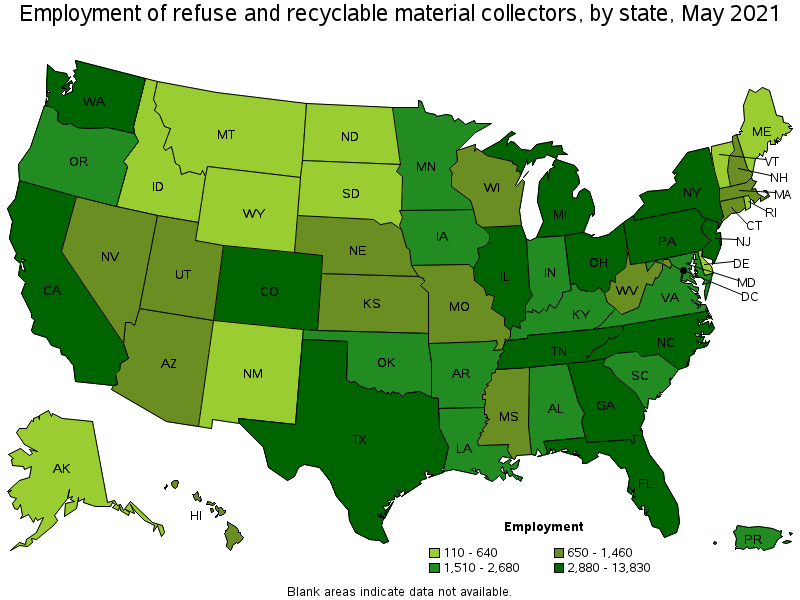
States with the highest employment level in Refuse and Recyclable Material Collectors:
| State | Employment (1) | Employment per thousand jobs | Location quotient (9) | Hourly mean wage | Annual mean wage (2) |
|---|---|---|---|---|---|
| California | 13,830 | 0.84 | 0.94 | $ 27.22 | $ 56,610 |
| Florida | 10,520 | 1.22 | 1.37 | $ 20.16 | $ 41,930 |
| Texas | 9,120 | 0.75 | 0.83 | $ 16.84 | $ 35,040 |
| New York | 7,350 | 0.85 | 0.95 | $ 30.74 | $ 63,930 |
| Ohio | 5,780 | 1.11 | 1.24 | $ 19.78 | $ 41,140 |
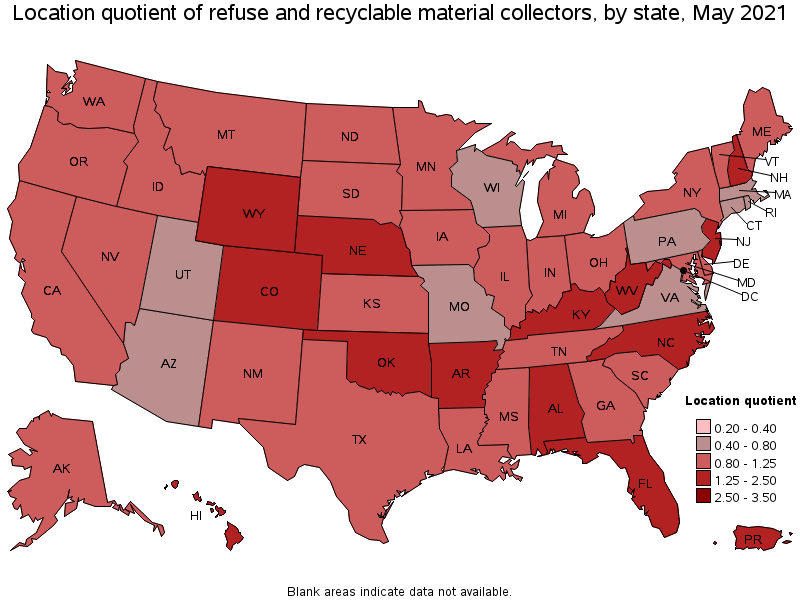
States with the highest concentration of jobs and location quotients in Refuse and Recyclable Material Collectors:
| State | Employment (1) | Employment per thousand jobs | Location quotient (9) | Hourly mean wage | Annual mean wage (2) |
|---|---|---|---|---|---|
| Arkansas | 1,820 | 1.53 | 1.71 | $ 15.36 | $ 31,950 |
| Oklahoma | 2,100 | 1.35 | 1.50 | $ 17.35 | $ 36,090 |
| Nebraska | 1,280 | 1.33 | 1.49 | $ 17.87 | $ 37,170 |
| Wyoming | 340 | 1.30 | 1.45 | $ 19.78 | $ 41,140 |
| Kentucky | 2,380 | 1.29 | 1.44 | $ 16.61 | $ 34,550 |
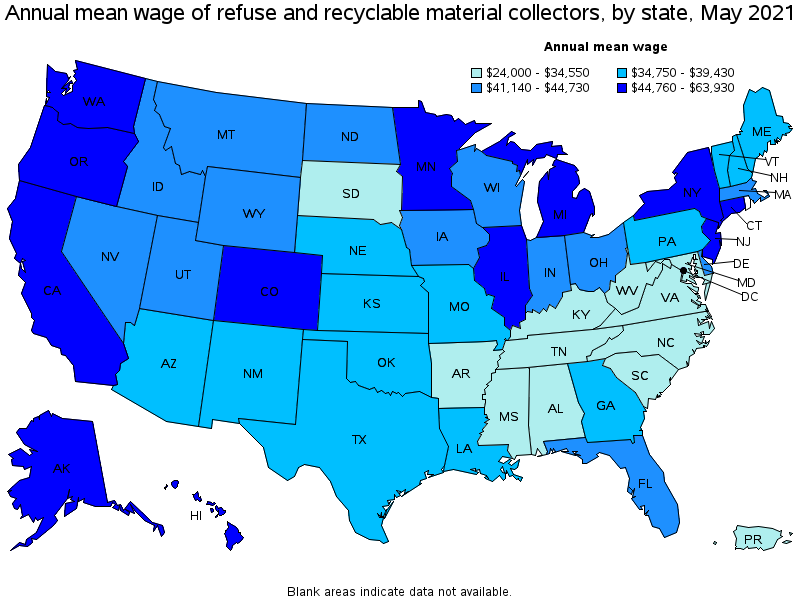
Top paying states for Refuse and Recyclable Material Collectors:
| State | Employment (1) | Employment per thousand jobs | Location quotient (9) | Hourly mean wage | Annual mean wage (2) |
|---|---|---|---|---|---|
| New York | 7,350 | 0.85 | 0.95 | $ 30.74 | $ 63,930 |
| Washington | 2,890 | 0.90 | 1.01 | $ 27.38 | $ 56,950 |
| California | 13,830 | 0.84 | 0.94 | $ 27.22 | $ 56,610 |
| Oregon | 1,960 | 1.07 | 1.20 | $ 25.53 | $ 53,100 |
| District of Columbia | 520 | 0.78 | 0.87 | $ 25.02 | $ 52,050 |
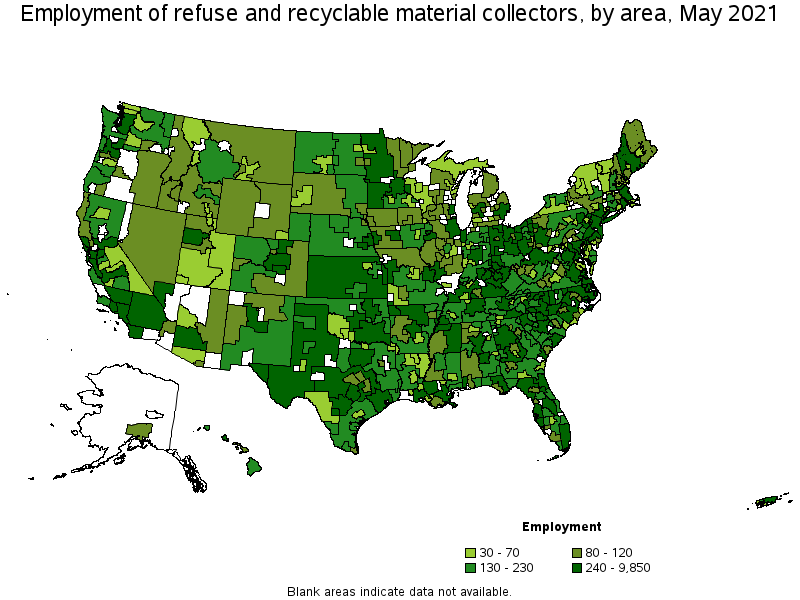
Metropolitan areas with the highest employment level in Refuse and Recyclable Material Collectors:
| Metropolitan area | Employment (1) | Employment per thousand jobs | Location quotient (9) | Hourly mean wage | Annual mean wage (2) |
|---|---|---|---|---|---|
| New York-Newark-Jersey City, NY-NJ-PA | 9,850 | 1.13 | 1.27 | $ 28.70 | $ 59,690 |
| Los Angeles-Long Beach-Anaheim, CA | 3,980 | 0.70 | 0.78 | $ 26.23 | $ 54,560 |
| Chicago-Naperville-Elgin, IL-IN-WI | 3,220 | 0.76 | 0.85 | $ 24.97 | $ 51,940 |
| Miami-Fort Lauderdale-West Palm Beach, FL | 3,000 | 1.22 | 1.37 | $ 21.79 | $ 45,320 |
| Dallas-Fort Worth-Arlington, TX | 2,940 | 0.82 | 0.92 | $ 16.50 | $ 34,320 |
| Washington-Arlington-Alexandria, DC-VA-MD-WV | 2,250 | 0.77 | 0.86 | $ 18.75 | $ 38,990 |
| Atlanta-Sandy Springs-Roswell, GA | 2,230 | 0.86 | 0.96 | $ 18.32 | $ 38,100 |
| San Francisco-Oakland-Hayward, CA | 2,160 | 0.96 | 1.08 | $ 33.40 | $ 69,470 |
| Tampa-St. Petersburg-Clearwater, FL | 2,010 | 1.56 | 1.74 | $ 20.96 | $ 43,610 |
| Charlotte-Concord-Gastonia, NC-SC | 1,880 | 1.56 | 1.74 | $ 17.95 | $ 37,330 |
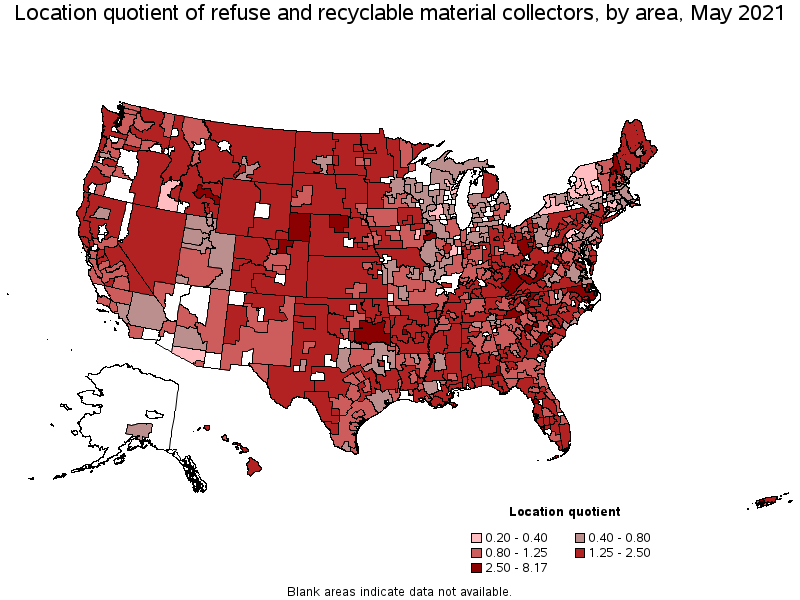
Metropolitan areas with the highest concentration of jobs and location quotients in Refuse and Recyclable Material Collectors:
| Metropolitan area | Employment (1) | Employment per thousand jobs | Location quotient (9) | Hourly mean wage | Annual mean wage (2) |
|---|---|---|---|---|---|
| Dothan, AL | 190 | 3.38 | 3.78 | $ 16.36 | $ 34,030 |
| Davenport-Moline-Rock Island, IA-IL | 530 | 3.11 | 3.48 | $ 23.32 | $ 48,510 |
| Idaho Falls, ID | 210 | 2.97 | 3.32 | $ 23.73 | $ 49,360 |
| Greeley, CO | 280 | 2.80 | 3.12 | $ 22.69 | $ 47,200 |
| Homosassa Springs, FL | 80 | 2.49 | 2.78 | $ 17.98 | $ 37,390 |
| Hot Springs, AR | 90 | 2.48 | 2.77 | $ 14.30 | $ 29,740 |
| Ocean City, NJ | 90 | 2.43 | 2.71 | $ 20.47 | $ 42,590 |
| Bloomington, IL | 170 | 2.08 | 2.33 | $ 20.64 | $ 42,920 |
| Florence-Muscle Shoals, AL | 100 | 2.00 | 2.24 | $ 16.42 | $ 34,140 |
| Laredo, TX | 190 | 2.00 | 2.23 | $ 14.93 | $ 31,060 |
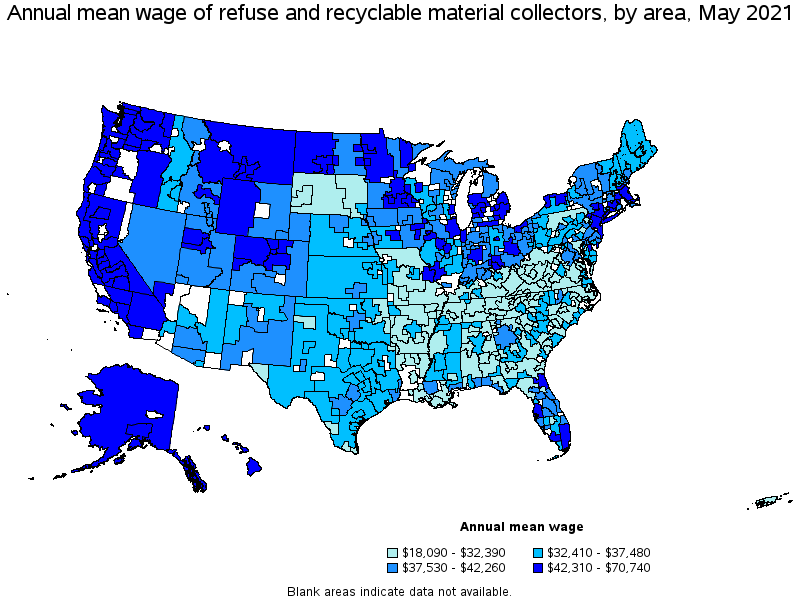
Top paying metropolitan areas for Refuse and Recyclable Material Collectors:
| Metropolitan area | Employment (1) | Employment per thousand jobs | Location quotient (9) | Hourly mean wage | Annual mean wage (2) |
|---|---|---|---|---|---|
| San Jose-Sunnyvale-Santa Clara, CA | 950 | 0.89 | 1.00 | $ 34.01 | $ 70,740 |
| San Francisco-Oakland-Hayward, CA | 2,160 | 0.96 | 1.08 | $ 33.40 | $ 69,470 |
| Napa, CA | 100 | 1.50 | 1.68 | $ 29.25 | $ 60,830 |
| Seattle-Tacoma-Bellevue, WA | 1,690 | 0.88 | 0.98 | $ 29.21 | $ 60,750 |
| Salinas, CA | 150 | 0.91 | 1.01 | $ 29.03 | $ 60,390 |
| New York-Newark-Jersey City, NY-NJ-PA | 9,850 | 1.13 | 1.27 | $ 28.70 | $ 59,690 |
| Santa Rosa, CA | 270 | 1.38 | 1.55 | $ 28.50 | $ 59,280 |
| Santa Maria-Santa Barbara, CA | 210 | 1.10 | 1.22 | $ 27.71 | $ 57,640 |
| Anchorage, AK | 110 | 0.66 | 0.74 | $ 27.56 | $ 57,330 |
| Oxnard-Thousand Oaks-Ventura, CA | 290 | 0.99 | 1.10 | $ 27.48 | $ 57,150 |
Nonmetropolitan areas with the highest employment in Refuse and Recyclable Material Collectors:
| Nonmetropolitan area | Employment (1) | Employment per thousand jobs | Location quotient (9) | Hourly mean wage | Annual mean wage (2) |
|---|---|---|---|---|---|
| Kansas nonmetropolitan area | 610 | 1.62 | 1.81 | $ 16.87 | $ 35,080 |
| Eastern Ohio nonmetropolitan area | 530 | 4.13 | 4.61 | $ 18.92 | $ 39,340 |
| Southeast Coastal North Carolina nonmetropolitan area | 510 | 2.13 | 2.39 | $ 13.51 | $ 28,110 |
| Piedmont North Carolina nonmetropolitan area | 430 | 1.75 | 1.95 | $ 12.88 | $ 26,800 |
| Southeast Oklahoma nonmetropolitan area | 420 | 2.56 | 2.86 | $ 16.33 | $ 33,960 |
Nonmetropolitan areas with the highest concentration of jobs and location quotients in Refuse and Recyclable Material Collectors:
| Nonmetropolitan area | Employment (1) | Employment per thousand jobs | Location quotient (9) | Hourly mean wage | Annual mean wage (2) |
|---|---|---|---|---|---|
| Eastern Ohio nonmetropolitan area | 530 | 4.13 | 4.61 | $ 18.92 | $ 39,340 |
| Northwest Nebraska nonmetropolitan area | 130 | 3.54 | 3.96 | $ 18.14 | $ 37,720 |
| Northern New Hampshire nonmetropolitan area | 120 | 3.43 | 3.84 | $ 17.70 | $ 36,820 |
| Northeast Coastal North Carolina nonmetropolitan area | 280 | 3.10 | 3.46 | $ 13.42 | $ 27,910 |
| Lower Savannah South Carolina nonmetropolitan area | 140 | 2.72 | 3.04 | $ 10.20 | $ 21,210 |
Top paying nonmetropolitan areas for Refuse and Recyclable Material Collectors:
| Nonmetropolitan area | Employment (1) | Employment per thousand jobs | Location quotient (9) | Hourly mean wage | Annual mean wage (2) |
|---|---|---|---|---|---|
| Coast Oregon nonmetropolitan area | 130 | 1.18 | 1.31 | $ 24.02 | $ 49,970 |
| North Valley-Northern Mountains Region of California nonmetropolitan area | 150 | 1.58 | 1.76 | $ 23.23 | $ 48,320 |
| Western Washington nonmetropolitan area | 160 | 1.38 | 1.54 | $ 22.92 | $ 47,670 |
| Eastern Oregon nonmetropolitan area | 110 | 1.51 | 1.69 | $ 22.57 | $ 46,940 |
| Hawaii / Kauai nonmetropolitan area | 180 | 1.98 | 2.21 | $ 22.53 | $ 46,870 |
These estimates are calculated with data collected from employers in all industry sectors, all metropolitan and nonmetropolitan areas, and all states and the District of Columbia. The top employment and wage figures are provided above. The complete list is available in the downloadable XLS files.
The percentile wage estimate is the value of a wage below which a certain percent of workers fall. The median wage is the 50th percentile wage estimate—50 percent of workers earn less than the median and 50 percent of workers earn more than the median. More about percentile wages.
(1) Estimates for detailed occupations do not sum to the totals because the totals include occupations not shown separately. Estimates do not include self-employed workers.
(2) Annual wages have been calculated by multiplying the hourly mean wage by a "year-round, full-time" hours figure of 2,080 hours; for those occupations where there is not an hourly wage published, the annual wage has been directly calculated from the reported survey data.
(3) The relative standard error (RSE) is a measure of the reliability of a survey statistic. The smaller the relative standard error, the more precise the estimate.
(7) The value is less than .005 percent of industry employment.
(9) The location quotient is the ratio of the area concentration of occupational employment to the national average concentration. A location quotient greater than one indicates the occupation has a higher share of employment than average, and a location quotient less than one indicates the occupation is less prevalent in the area than average.
Other OEWS estimates and related information:
May 2021 National Occupational Employment and Wage Estimates
May 2021 State Occupational Employment and Wage Estimates
May 2021 Metropolitan and Nonmetropolitan Area Occupational Employment and Wage Estimates
May 2021 National Industry-Specific Occupational Employment and Wage Estimates
Last Modified Date: March 31, 2022